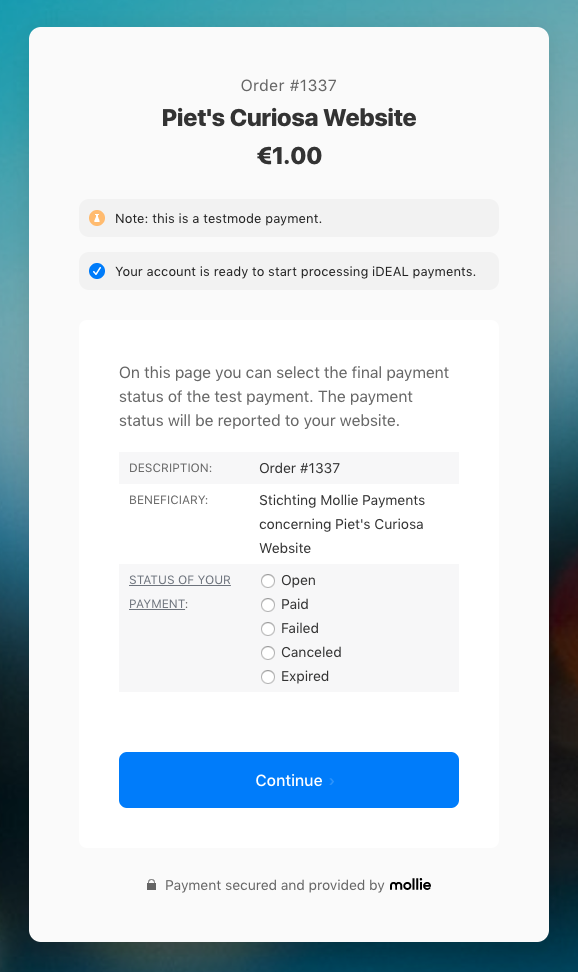Testing Mollie API
During the process of building your integration, it is important to properly test it. You can access the test mode of the Mollie API in two ways: by using the Test API key, or, if you are using organization access tokens or app tokens, by providing the testmode parameter in your API request.
Any payments or other resources you create in test mode are completely isolated from your live mode data. Going back and forth between test and live mode is as easy as switching out the API key - or toggling the testmode parameter in case of the other authentication methods.
Please note that all API endpoints which are related to business operations, do not support test mode.
Test mode checkout screen
When creating payments or orders in test mode, the regular checkout hosted payment pages will be replaced by a test mode checkout screen. Most test mode payment resources will feature a checkout URL just like in live mode, which then allows you to walk through the payment process without spending actual money. You can try out different payment statuses and see whether your integration handles it correctly.

Testing Recurring payments and chargebacks
For test mode recurring payments, the resource will not contain a checkout URL, because these payments are executed without any interaction of your customer. Instead, a changePaymentState URL is added, which allows you to set the final payment state for these payments.
For paid test mode payments the resource will also include the changePaymentState URL which allows you to create a refund or chargeback for that payment directly from our hosted payment page. This can be used to test refund and chargeback functionality.
Apart from the hosted payment pages and the fact that test mode payments are created instead of real ones, the Mollie API behaves identical in both environments. This includes calling your webhook.
Testing card payments
Credit card payments can fail for various reasons ranging from having provided an invalid card number to having the card issuer reject the payment due to insufficient funds. In the case of a failed credit card payment, the API therefore includes a failureReason in the payment response to provide more context.
To test the various failure reasons the Mollie API can return, you can create your test mode card payment with a specific amount according to the table below. If you then force the payment to the failed status in the test flow, the payment response will include the appropriate failure reason.
| Failure reason to trigger | Magic amount |
|---|---|
invalid_card_number | € 1,001.00 |
invalid_cvv | € 1,002.00 |
invalid_card_holder_name | € 1,003.00 |
card_expired | € 1,004.00 |
invalid_card_type | € 1,005.00 |
refused_by_issuer | € 1,006.00 |
insufficient_funds | € 1,007.00 |
inactive_card | € 1,008.00 |
possible_fraud | € 1,009.00 |
authentication_failed | € 1,010.00 |
card_declined | € 1,011.00 |
Testing different types of cards
You can use the test card numbers below to test different card brands. This works for both Mollie Checkout as well as Mollie Components.
| Brand | Card number | Expiry date | CVV |
|---|---|---|---|
| American Express | 3782 822463 10005 | Any | Any |
| Mastercard | 2223 0000 1047 9399 | Any | Any |
| VISA | 4543 4740 0224 9996 | Any | Any |
Note:The card brand above allows you to test the dynamic display of the card logo in the card number field. For the time being, when processed the test payment will default to Mastercard always.
Testing Webhooks
Testing Webhooks is essential because it ensures that your system can reliably receive, process, and respond to real-time events. Webhooks often trigger critical workflows, so even small errors in configuration, payload handling, or security can lead to missed payments, transaction inconsistencies, or broken features.
Refer to our Webhooks best practices for more information on testing and best ways to set them up.
Testing POS
We offer testing functionality for our point-of-sale offering by supporting test mode for the Terminals API. For full instructions on testing your terminal, see our Testing your point-of-sale integration article.
Demo accounts
To integrate Mollie, create an account via our Web App. Once registered, you can enable the payment methods you want to test with. In test mode, payment methods are activated immediately even when they show as pending. Please note that pending payment methods cannot be used in live mode.
Alternatively, we now offer dedicated Demo Accounts that are designed for exploring Mollie functionality without real transaction implications. This lets you validate your integration approach and discover functionality before committing to full implementation. Demo Accounts are currently in early access — contact your Mollie representative to request access.